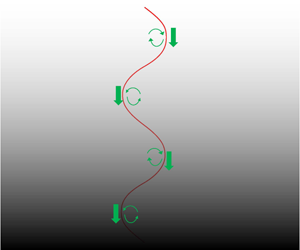Crossref Citations
This article has been cited by the following publications. This list is generated based on data provided by
Crossref.
Breoni, D.
Löwen, H.
and
Blossey, R.
2021.
Active noise-driven particles under space-dependent friction in one dimension.
Physical Review E,
Vol. 103,
Issue. 5,
Jan Schwarzendahl, Fabian
and
Löwen, Hartmut
2021.
Barrier-mediated predator-prey dynamics.
EPL (Europhysics Letters),
Vol. 134,
Issue. 4,
p.
48005.
Shaik, Vaseem A.
and
Elfring, Gwynn J.
2021.
Hydrodynamics of active particles in viscosity gradients.
Physical Review Fluids,
Vol. 6,
Issue. 10,
Feng, Chao
Molina, John J.
Turner, Matthew S.
and
Yamamoto, Ryoichi
2023.
Dynamics of microswimmers near a liquid–liquid interface with viscosity difference.
Physics of Fluids,
Vol. 35,
Issue. 5,
Feng, Chao
Molina, John J.
and
Yamamoto, Ryoichi
2023.
Dynamics of a Model Microswimmer in the Vicinity of a Liquid Droplet.
Journal of the Physical Society of Japan,
Vol. 92,
Issue. 7,
Gong, Jiahao
Shaik, Vaseem A.
and
Elfring, Gwynn J.
2023.
Active particles crossing sharp viscosity gradients.
Scientific Reports,
Vol. 13,
Issue. 1,
Esparza López, Christian
and
Lauga, Eric
2023.
Rate invariance and scallop theorem in viscosity gradients.
Physical Review Fluids,
Vol. 8,
Issue. 6,
Aghaei, Elika
Jannesari Ghomsheh, Mehryar
Behrouzi, Kamyar
Jafari, Azadeh
and
Raisee Dehkordi, Mehrdad
2023.
Bioinspired enzyme-powered microswimmer for pH-sensitive locomotion in the gastric mucus.
AIP Advances,
Vol. 13,
Issue. 8,
More, Rishabh V.
and
Ardekani, Arezoo M.
2023.
Motion in Stratified Fluids.
Annual Review of Fluid Mechanics,
Vol. 55,
Issue. 1,
p.
157.
Anand, Vishal
and
Narsimhan, Vivek
2023.
Dynamics of spheroids in pressure-driven flows of shear thinning fluids.
Physical Review Fluids,
Vol. 8,
Issue. 11,
Kamal, Catherine
and
Lauga, Eric
2023.
Resistive-force theory of slender bodies in viscosity gradients.
Journal of Fluid Mechanics,
Vol. 963,
Issue. ,
Gong, Jiahao
Shaik, Vaseem A.
and
Elfring, Gwynn J.
2024.
Swimming efficiency in viscosity gradients.
Journal of Fluid Mechanics,
Vol. 998,
Issue. ,
Anand, Vishal
and
Narsimhan, Vivek
2024.
Sedimentation of spheroids in Newtonian fluids with spatially varying viscosity.
Journal of Fluid Mechanics,
Vol. 983,
Issue. ,
Liu, Zhaorong
Chao, Youchuang
Zheng, Zhijun
and
Zhu, Lailai
2024.
Spontaneous oscillation of an active filament under viscosity gradients.
Soft Matter,
Vol. 20,
Issue. 18,
p.
3845.
Mrokowska, Magdalena M.
and
Krztoń-Maziopa, Anna
2024.
Settling of microplastics in mucus-rich water column: The role of biologically modified rheology of seawater.
Science of The Total Environment,
Vol. 912,
Issue. ,
p.
168767.
Khain, Tali
Fruchart, Michel
and
Vitelli, Vincenzo
2024.
Viscous tweezers: Controlling particles with viscosity.
Physical Review Research,
Vol. 6,
Issue. 4,
Gong, Jiahao
Shaik, Vaseem A.
and
Elfring, Gwynn J.
2024.
Active spheroids in viscosity gradients.
Journal of Fluid Mechanics,
Vol. 984,
Issue. ,
Gao, Gang
Wang, Yangjun
Liu, Kefeng
Cao, Liushuai
and
Wan, Decheng
2025.
Large eddy simulation of stratified flow past prolate spheroids with varying aspect ratios.
Physics of Fluids,
Vol. 37,
Issue. 2,
Mrokowska, Magdalena M.
Dzień, Karolina
and
Krztoń-Maziopa, Anna
2025.
Effects of rheologically stratified seawater during algal bloom on sinking dynamics of microplastics.
Water Research,
Vol. 280,
Issue. ,
p.
123487.

 $0<Pe<3$), the swimmer prefers regions of low viscosity, while for high Péclet numbers (
$0<Pe<3$), the swimmer prefers regions of low viscosity, while for high Péclet numbers ( $Pe>3$), the swimmer prefers regions of high viscosity. Our analysis shows that purely hydrodynamic effects might be responsible for the experimentally observed accumulation of swimmers near favourable viscosity regions. We find that viscosity gradients influence other motility characteristics of the swimmer, such as power expenditure and hydrodynamic efficiency, and provide analytical expressions for both.
$Pe>3$), the swimmer prefers regions of high viscosity. Our analysis shows that purely hydrodynamic effects might be responsible for the experimentally observed accumulation of swimmers near favourable viscosity regions. We find that viscosity gradients influence other motility characteristics of the swimmer, such as power expenditure and hydrodynamic efficiency, and provide analytical expressions for both.